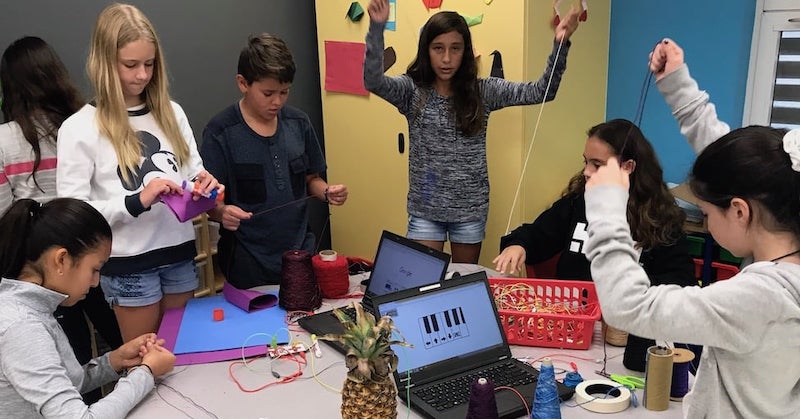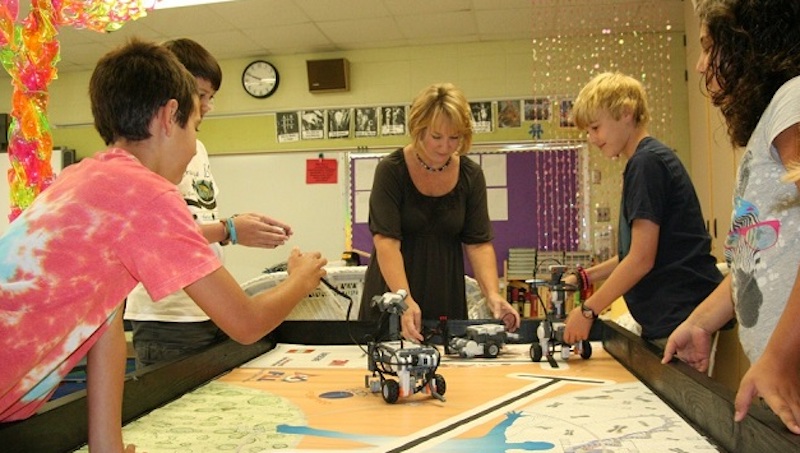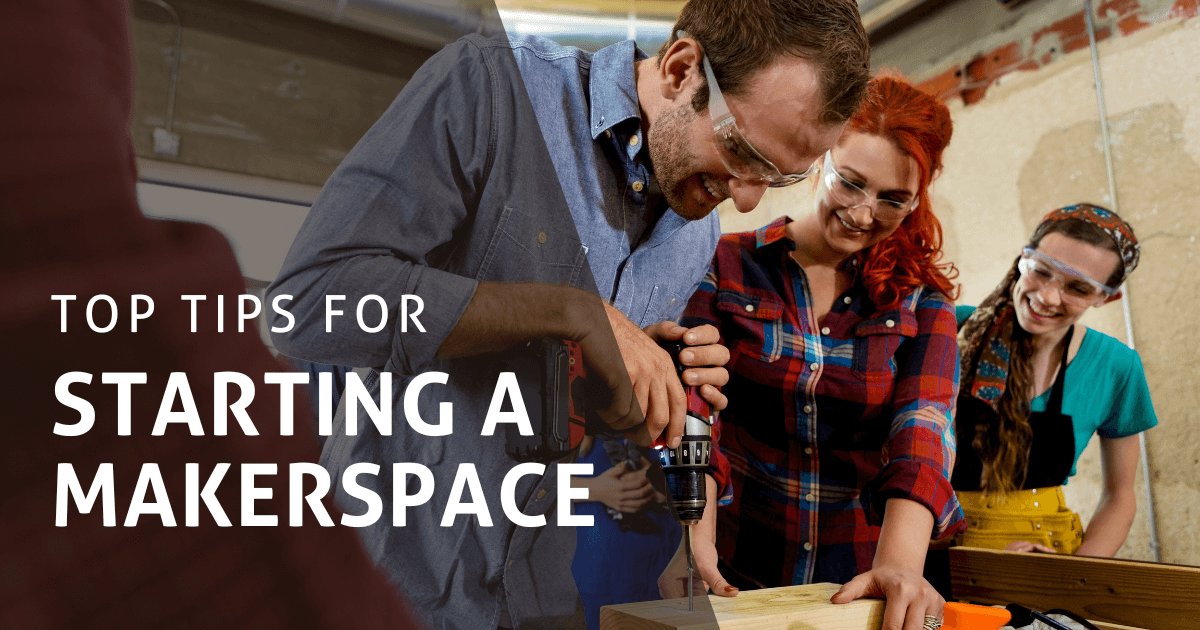In the current era of innovative education, we see plenty of trendy buzzwords. Some trends fade out just as quickly as they appear, but others stick around for the long haul. One such movement is Maker Education, which seems like it'll be part of education for the foreseeable future. MakerEd embodies the tenets of the Maker Movement by empowering students to design solutions, create collaboratively, and fail productively. Because the values of maker learning are closely connected to 21st-century learning experiences, the popularity of school makerspaces continues to increase. So, when it comes to starting a makerspace in your school, what are the most important things you need to know?
Starting a Makerspace for Beginners
The great thing about makerspaces is that they're completely customizable. There's no one structure for creating the best makerspace. In fact, any makerspace that creates productive STEM learning experiences can be considered a success. Because makerspaces are so versatile, they are located in many different types of places, including libraries, community centers, and, of course, schools. Wherever they are, makerspaces serve as creative workshops and collaborative communities for makers of any age to turn ideas into tangible designs—often geared towards solving a specific community problem. In keeping with a spirit of community, makerspaces often start with teamwork. Whether your makerspace team consists of K-12 teachers, curriculum coordinators, technology specialists, or all of the above, it's essential to work together to get a makerspace off the ground.
Key elements to decide when starting a makerspace.
For those new to maker education, an important first step is to do some research. If you're reading this blog, you're already on the way! Educators should learn about the educational potential of makerspaces before introducing one to their school. This helps them identify makerspace equipment they might want to include and find project ideas for students to work on. For example, some schools might favor a crafty atmosphere, with cardboard supplies and Cricut cutters, to incorporate MakerEd into art class. A tech school might add 3D printers and robotic arms to their makerspace for a STEM-centered approach. Just remember that makerspaces aren't one-size-fits-all. You can tailor your makerspace to your specific needs—it's impossible to do it wrong!
After developing an idea of what direction to take your makerspace, the next step is to settle on a location. Educators will need to take multiple factors into account when deciding a location, such as the availability of space, number of students and faculty members, type of equipment, expansion goals, and more. Is this makerspace just for your class, or will the entire school share it? How much equipment fits into the budget? Again, there's no right or wrong answer. School makerspaces can start as small as the corner of a classroom or take up an entire library. They might be centered around a specific subject, like engineering, or include stations for different activities, from repurposing waste to video editing. All that matters is that students can access effective hands-on learning opportunities.
Getting Help from the Community
There's no recipe for starting a school makerspace, but there are plenty of successful examples to study. Once you have a plan for advancing student creativity through a makerspace, it's time to start gathering resources. The budget allotted for a school makerspace will likely be fairly thin, so educators have to make these funds count. Makerspace teachers routinely request community help in this regard. Whether it's rounding up used cardboard, acquiring donations of maker supplies, or finding various materials for upcycling or repurposing, chances are someone is getting rid of something that would make a great makerspace tool. Either way, leaning on the surrounding community can make a daunting beginning into an exciting adventure.
The right materials and the right messages.
People throw away useful makerspace materials all the time. One strategy to jumpstart your collection could be setting up a separate recycling station in your school for everyone to place materials that could be upcycled. It's also a great way to create buzz and spread key tenets of the Maker Movement. Along those lines, taking advantage of a nearby maker community is also helpful. Almost every major city has a community of makers who could come in for demos, talk about their experiences, and inspire students to use maker tools for good. This helps students develop their own maker mindset and see the good they can do through maker projects to impact the world beyond their school.

Creating an Inclusive Makerspace
When starting a makerspace, you may be tempted to spend energy finding the coolest new technologies. In many cases, however, it's best to focus on developing the accessibility and sustainability of the makerspace, factors which can have a major impact on student experiences. In an era in which we focus so much on equity in education, makerspaces shouldn't be left out. Designing a space that's completely accessible and filling it with maker tools that are equally effective for students of all abilities and skill levels is very important. Plus, in an age of environmental awareness, it's essential to promote sustainability in all learning spaces. Accessibility and sustainability go hand in hand, creating a healthier world for all who live in it.
Including the right supplies for your students.
Let's start with accessibility. To design a fully inclusive space, educators should consider all sorts of student abilities. Some students will struggle with hands-on learning, preferring to learn by reading and writing, while others naturally thrive in a makerspace. Students may have physical or intellectual disabilities that limit the range of tools they can use, or they might have learning differences or neurodivergence that influences how they approach making. By bringing a wide variety of tools into the makerspace, educators can ensure that all students can participate. Many MakerEd tools also grow alongside students, with multiple levels of difficulty. That means students of all abilities or grade levels can use the same tools, keeping your makerspace cost-efficient and encouraging collaboration. With the right tools, creativity and purposeful invention should fall right into place.
Stay flexible and minimize waste.
Something else to consider is the sustainability of the makerspace's supplies and practices. Since students often work on different projects, they'll need a wide variety of materials, but that doesn't mean that makerspaces automatically produce a lot of waste. Makerspace learning is all about maximizing resources. Many supplies can be items that were already on their way to the trash or recycling, such as papers, cardboard, bottles and cans, string, and more. And educators can challenge students to think of more sustainable ways to create. Maybe they'll use eco-friendly 3D-printer filament or build a model of green energy equipment. Teaching students to reuse, reduce, and recycle in a makerspace can inspire them to do the same in their classrooms and homes. And reducing makerspace waste isn't only about the physical supplies. Students should also learn to shut off lights, appliances, and other tech when they're not using them.
The Teacher's Role in a School Makerspace
We've covered some of the things educators can do to prepare for starting a makerspace. The teacher's work, however, does not stop once the makerspace is open. But teaching in a makerspace looks different from teaching in a classroom. Makerspace experiences provide students with freedom to create and fail. They'll learn just as much from doing something the wrong way as they would from doing it perfectly. The process of failure is a key cog in their development, fostering perseverance and ingenuity as they work to overcome obstacles. So, in many cases, makerspace teachers should take a step back from direct intervention in their students' projects. Rather, teachers can act as more of a knowledgeable guide for their new makers.
Working with other teachers.
As students start using a school makerspace more regularly, teachers should be able to pick up on trends and share this information with other teachers. That way, teachers across subjects can relate students' makerspace experiences to what they're learning in their other classes. This goes for hyping up the makerspace as well. It helps if other teachers in the school encourage students to use the makerspace or even show them how to use it. Although some students may be reluctant to give it a try, they'll soon warm up to the many opportunities for building, tinkering, investigating, and even breaking things. Most importantly, everyone should understand that the makerspace is a free place for invention, togetherness, and discovery.
Makerspaces and curriculum connections.
Although makerspaces facilitate plenty of unique learning experiences, teachers may need to connect makerspace learning to the broader curriculum. Incorporating curricula into MakerEd helps students stay on task and gain hands-on experience with any subject. However, some school makerspaces focus more on afterschool experimentation than standards-aligned learning. Typically, distancing makerspace experiences from learning requirements frees up creative experimentation without the added pressures of grades, projects, or deadlines. And, students can accomplish a whole lot with the right support and the proper tools. Whether they're using circuitry kits, old egg cartons, simple electronic components, or thousands of other materials, students will be inspired to turn their ideas to a reality.
Design challenges when starting a school makerspace.
Regular themes and routines can help educators create a community of like-minded makers. Even young students can buy into this way of thinking. One way to build camaraderie among students is by leading regular design challenges. These experiences help them move beyond simply designing projects for a grade. Design challenges are more about which individual or team can design a solution with a lasting real-world impact, which is what maker education is all about. Extending design challenges school-wide can also develop a school maker community at the same time. This takes makerspace experiences to the next level—showing students what's really possible through making.

Final Elements to Consider When Starting a Makerspace
We've covered a lot, and we know starting a makerspace can be daunting. For teachers who are new to makerspaces, knowing what to expect is especially valuable. The design and functionality of your makerspace can go in any number of directions. The biggest thing to remember, however, is to make the space as inviting as possible. This will be a new experience for many students, and including things they recognize can make them feel more comfortable. If the makerspace looks like a place they could have fun and feel safe, more students are likely to get excited. Bright colors, along with comfortable furniture, can really help with that first impression.
Staying organized in the makerspace.
Makerspace experiences involve students developing not only technical skills but also key soft skills. Besides competencies like collaboration, communication, and self-expression, kids will also get the chance to learn about organization. Oftentimes, they have tons of different ideas for projects they’d like to complete, which is great. Organizing these projects and tackling them in a logical order, however, can be more of a challenge. Discussing or voting on which projects to complete as a class can be a good way to narrow it down. Organization also comes into play when keeping the many supplies in a makerspace easy for everyone to find. It takes everyone to keep makerspaces organized—a collaborative effort underscored by the sense of community associated with the Maker Movement.
If you are interested in starting a makerspace in your school or library and need some insights or guidance on what to expect, features to focus on, and MakerEd tools to acquire, we'd love to help. Our makerspace experts would be happy to set up a discussion to learn more about your vision. Please feel free to contact us any time to set up a conversation. Also, for the latest EdTech, STEM, and 21st century education news, follow us on Twitter/X and Instagram. Like us on Facebook, too, or sign up for our newsletter for our latest product announcements and offerings. If you have an idea for an Eduporium Weekly theme, send our team a message on social media or comment below.



